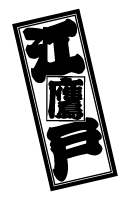| ■ 名 称 | 九
十九サイクルスポーツ Tsukumo Cycle Sports |
||
| ■ 代 表 | 田
辺昭夫 Akio Tanabe |
||
| ■ 所在地 | 〒
152-0002 東京都目黒区目黒本町1-16-21 1-16-21 Meguro-Honcho, Meguro-Ku, Tokyo, 152-0002 JAPAN |
||
| ■ 業務内容 | オ リジナルブランド「カラビンカ」レーシングフレーム(トラック・ロード)・ラグ・ハンガーシェル・エンドなどの製作。 | ||
| TEL/FAX 03-3710-1435 | |||
|
|
|||
|
迦陵頻迦(Ka-Ryou-Bin-Ga, Japanese. Kalavinka,
Sanskrit.) Kalavinka |
|||
 |
 |
 |
|
| ヘッ
ドバッジ Head Badge |
江
戸鷹 千社札 "Edo-Taka" The Senja-Fuda |
||
| Senjafuda (also referred to as Senshafuda) is a card
or slip stuck to shrines and temples on which visitor's name is
printed as a memorial of the visit. Edo is old name of Tokyo. |
|||
|
|
|||
|
|
|||